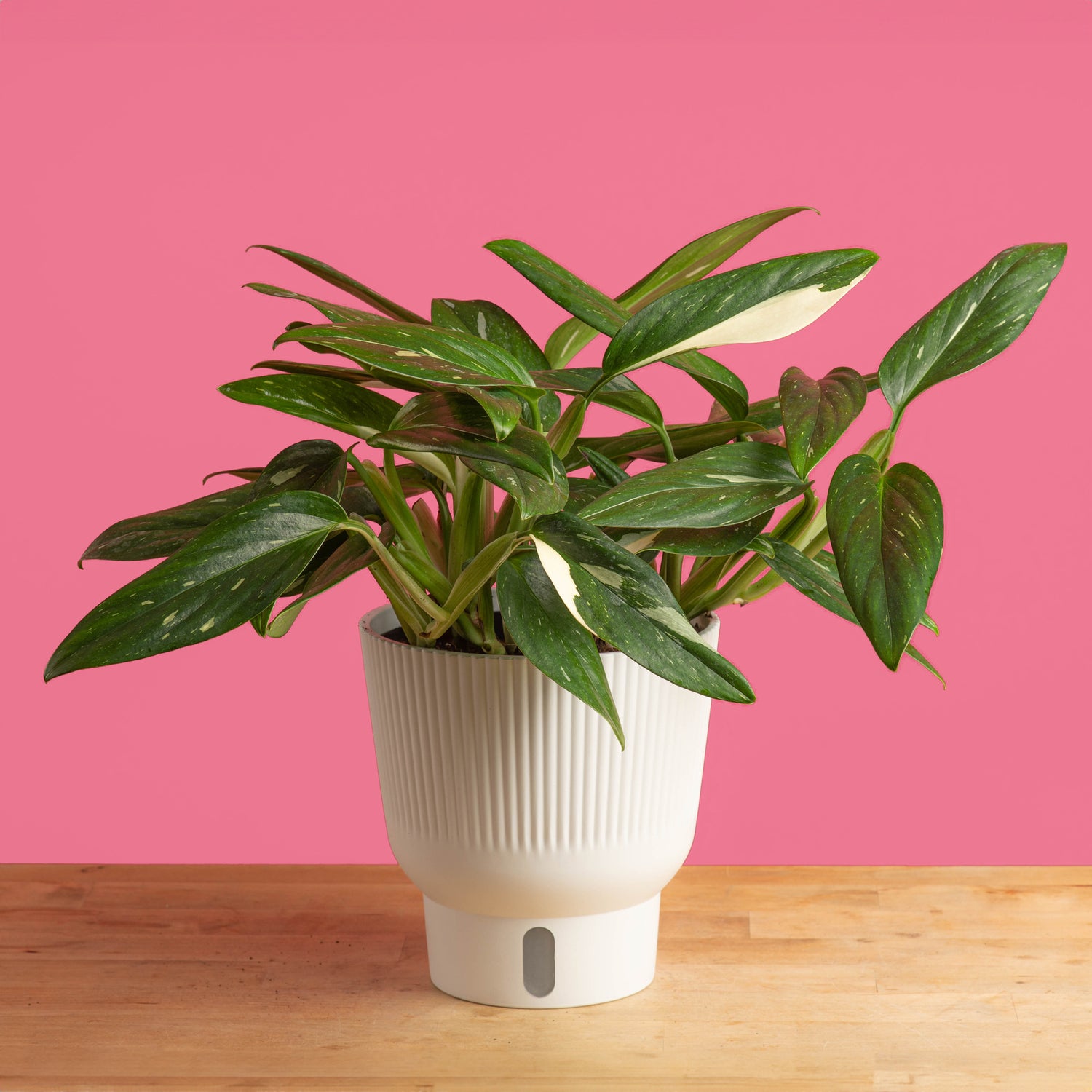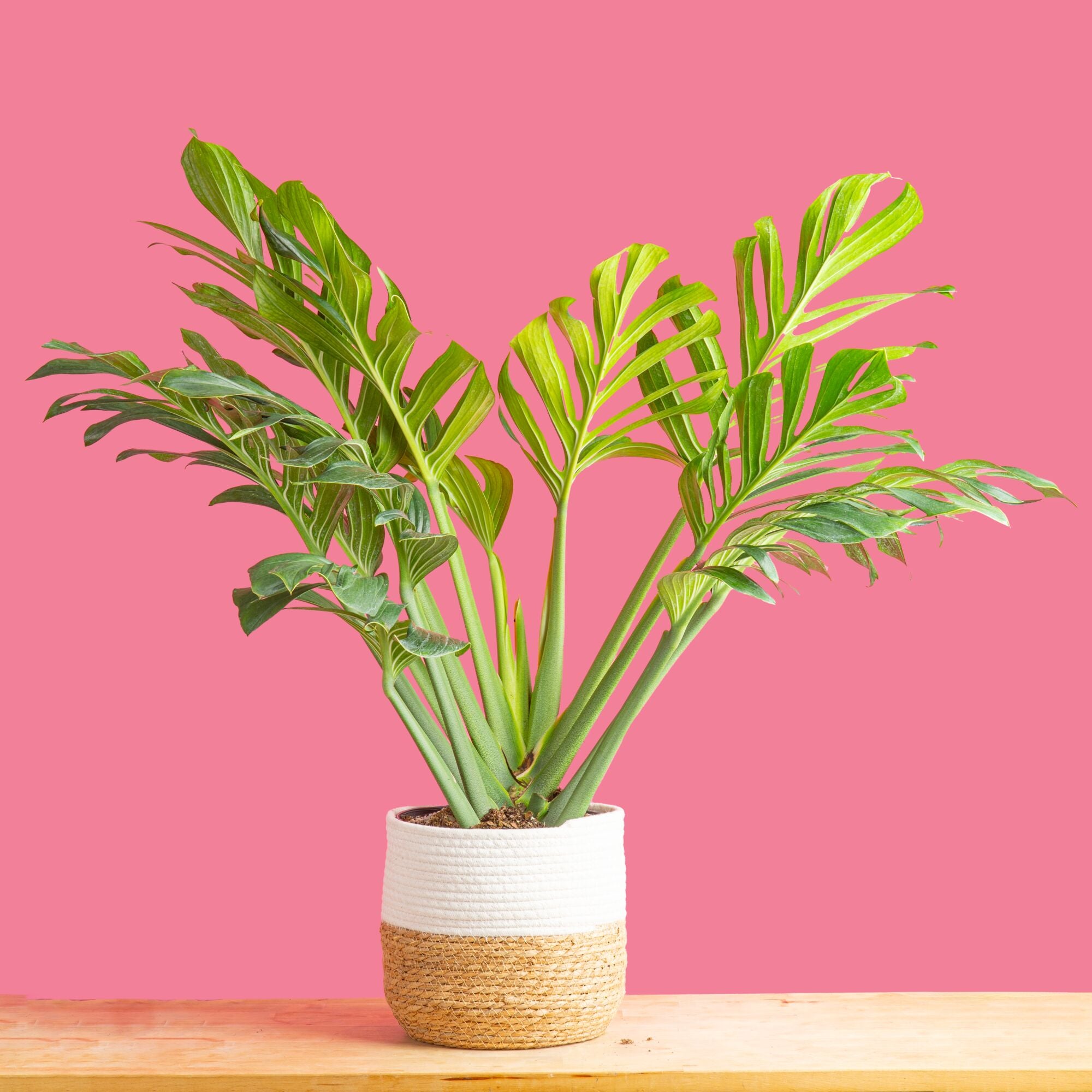How to care for a Monstera houseplants
Care guide for Monstera houseplants in 6- or 10-inch pots, including watering, light, humidity, fertilizing, repotting, propagation, and plant toxicity.
Monstera is a popular tropical houseplant known for its large, glossy leaves and signature holes or splits (called fenestrations). The most well-known variety is Monstera deliciosa, but Costa Farms also offers other types like Monstera adansonii, Monstera Esqueleto, Monstera Burle Marx Flame, Monstera subpinnata, and Monstera ‘Thai Constellation’ among others. While their care is similar, some small differences matter depending on the variety you have.

Watering Your Monstera
Most Monstera varieties like their soil to be evenly moist but not soggy. Let the top 50% to 75% of the soil dry out between waterings. Insert a wooden skewer or chopstick halfway into the soil. If it comes out clean and dry, it's time to water. If damp soil clings to it, wait a few days.
Watering guidelines by pot size:
6-inch pot: About 1 cup of lukewarm water
10-inch pot: About 3 cups of lukewarm water
Pour water slowly and evenly over the soil surface so all roots are moistened. Avoid watering directly into the base of the plant or onto the leaves.
Important: Never allow your Monstera to sit in standing water. If it’s in a decorative outer pot, empty any water from the cachepot or saucer 15–20 minutes after watering.
Variety-specific watering notes:
Monstera adansonii has a finer root system and smaller pot volume, especially in hanging baskets. Use about ½ to 1 cup of water for a 6-inch pot and check moisture more frequently.
Monstera ‘Thai Constellation’ is more sensitive to overwatering. Let the soil dry closer to 75% before watering again. Make sure the soil drains very well to avoid root stress.![]()
![]()

Light Requirements
Monsteras thrive in bright, indirect light. A few hours of early morning sun (before 10:30 a.m.) is fine, but they should be protected from strong midday or afternoon sun, which can cause leaf burn.
If your Monstera isn’t getting enough light, you may notice:
Smaller new leaves
Long gaps between leaves (leggy growth)
No splits or holes in mature leaves
The plant leaning toward the light source
Rotate your plant every couple of weeks to promote even growth.
Light notes by variety:
Thai Constellation needs more light than green varieties to maintain its variegation. A bright east- or south-facing window (filtered) is ideal.
Adansonii tolerates slightly lower light but will grow leggier and produce fewer holes in low-light settings. Climbing growth may slow.

Fertilizing
Fertilize during the spring and summer growing season only. Use a balanced houseplant fertilizer (such as 20-20-20) or a time-release formula, applied monthly or according to label instructions.
Avoid fertilizing in fall and winter, when the plant’s growth slows down. Too much fertilizer in the off-season can damage roots or lead to salt buildup in the soil.
Fertilizing tip for variegated varieties:
Thai Constellation has less chlorophyll than fully green plants and grows more slowly. Fertilize monthly at half strength to prevent overfeeding.

Temperature and Humidity
Monstera prefers warm, slightly humid conditions, similar to its tropical origins.
Ideal conditions:
Temperature: Keep above 60°F (growth slows below 55°F)
Humidity: Prefers 40–60% or higher
If your home is very dry—especially during winter—consider:
Using a humidifier
Grouping plants together
Placing the pot on a tray of pebbles with water (keep the pot above the water line)
Avoid placing your plant near cold drafts, AC vents, or heaters as processed air blowing on the plant will strip away moisture from the leaves.
Growth Habit
Most Monstera species are natural climbers. In the wild, they use aerial roots to climb trees and other surfaces. Indoors, your Monstera may benefit from a moss pole, coir pole, or trellis as it matures. This helps support upward growth and encourages larger, fenestrated leaves.
Monstera adansonii, in particular, tends to trail or climb depending on how it’s trained, and can be grown in a hanging basket or allowed to climb a support.
Common Leaf Concerns
Yellow leaves + soggy soil = overwatering or poor drainage
Crispy edges = underwatering or dry air
No fenestrations in new leaves = not enough light or a young plant
Curling or black spotting = watering too infrequently or exposure to cold
Note: Splitting leaves are normal, especially as Monsteras mature. If leaves are not splitting, your plant may need more light or time.
Repotting
Monstera grows moderately indoors and generally needs repotting every 12–24 months. You’ll know it’s time to repot if:
Roots are growing out of the drainage holes
Water runs straight through the pot
Growth has slowed despite regular care
When repotting:
Move up one pot size only---if your plant is in a 6-inch pot go up to an 8-inch pot. If your plant is in a 10-inch pot go up to a 12-inch pot.
Use a well-draining indoor potting mix (look for a blend with peat or coir, perlite, and bark)
Avoid soil that’s heavy, compacted, or holds water for too long—this increases the risk of root rot.
More on repotting here:
http://www.costafarms.com/get-growing/news/repotting-houseplants
https://www.youtube.com/watch?v=aRCiKuzwG_0

Propagating Monstera
Most Monstera varieties, including Monstera deliciosa and Monstera adansonii, are easy to propagate through stem cuttings.
How to propagate:
Look for a healthy stem with at least one node (the joint where roots grow).
Cut just below the node with clean scissors or pruners.
Place the cutting in clean water (or moist sphagnum moss or soil) with the node submerged.
Place in bright, indirect light. Roots usually appear within 2–4 weeks.
Once roots are 1–2 inches long, plant in a small pot with well-draining soil.
Note for Thai Constellation:
This variety is typically tissue-cultured and is not easily or reliably propagated at home. Attempting to propagate may damage the plant or produce unstable variegation.
⚠️ Toxicity Note
All Monstera varieties are considered toxic if ingested by pets or people. They contain insoluble calcium oxalates, which can cause irritation or swelling if chewed or eaten. Keep out of reach of cats, dogs, and small children.